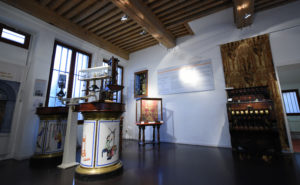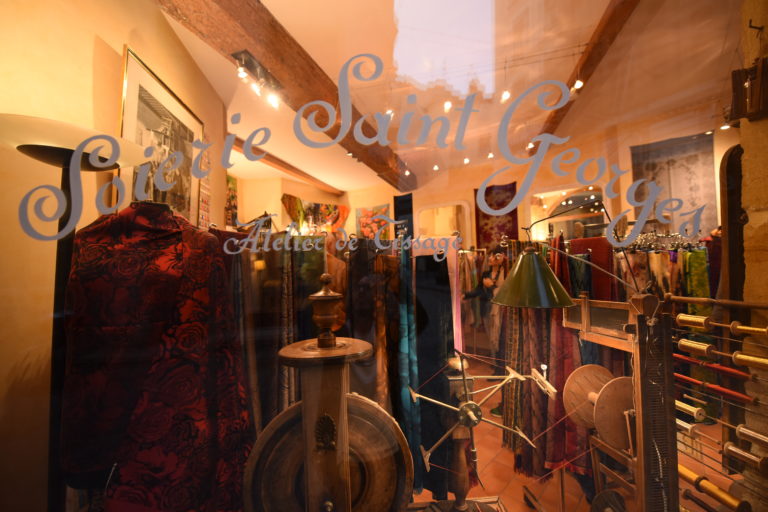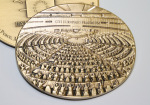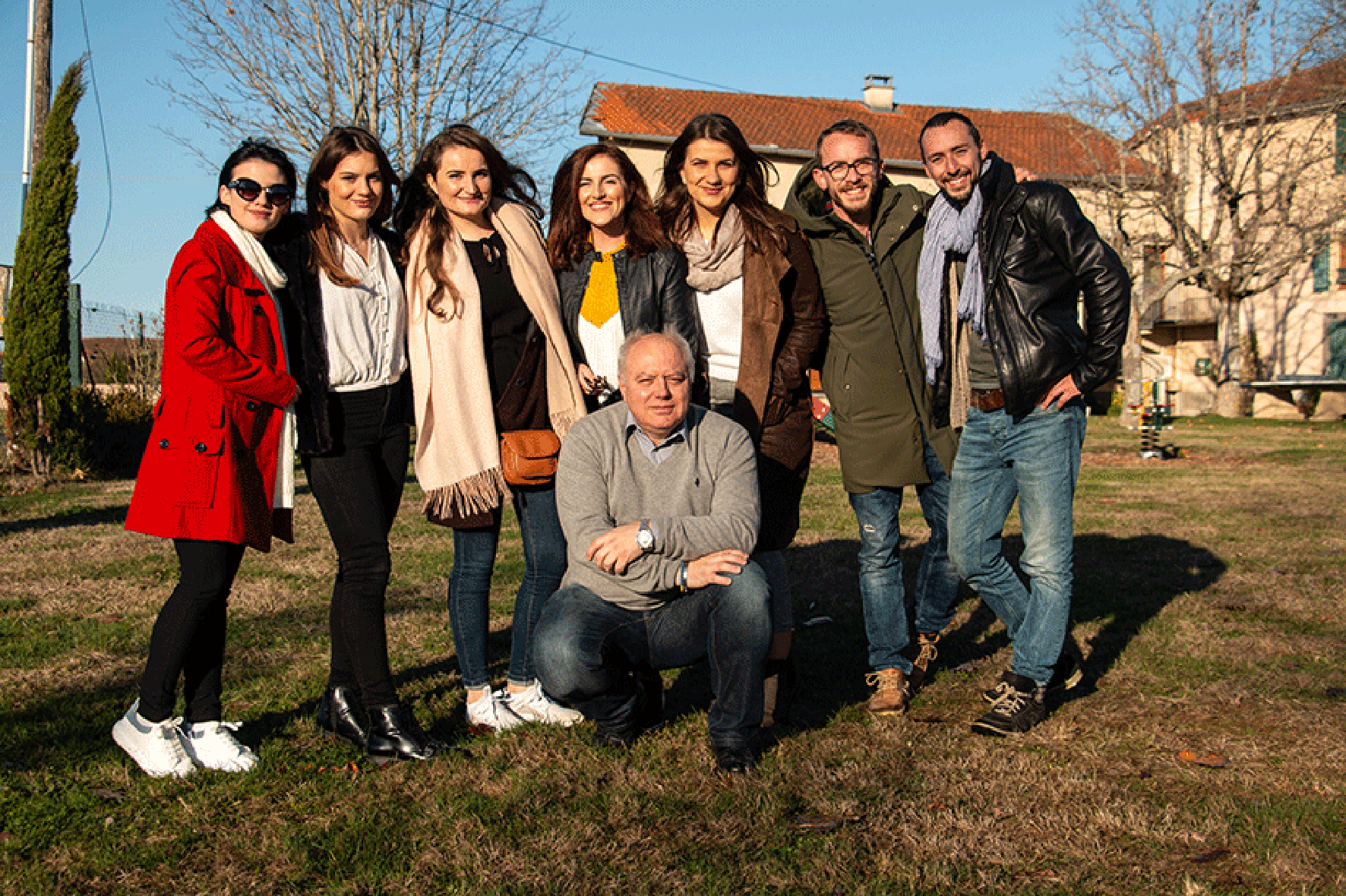In the capital of silk, tradition lives on
![]()
Exploring Lyon, is a great adventure, where modernity and tradition clash to offer unforgettable memories. The city known as the capital of silk, offers a rich history of ancient art of silk that has held onto its prestige thanks to the craftspeople who continue to work with dedication and great passion in the modern days.
Back in 19th Century, J.M.Jacquard invented his famous semi-automatic silk weaving looms and since that time, Rhône-Alpes has become France’s biggest silk producing region. The city of Lyon has its famous silk weavers, the Canuts. Their history still lives within “Maison des Canuts”, which includes workshop and a museum. Both show the history of the Canut silk workers, which once lived in difficult conditions and revolted to demand fair compensation for their silk.

@ Adnan Beqiri
“Maison des Canuts” is located in the old part of the town, 27 minutes by walk, from the “City Hall” and it welcomes around 40 thousand visitors during a year. They pay only 7 euros to experience a tour in two separated buildings. Inside museum, a permanent exhibition displays pictures, objects, machines and different materials, such as colorful threads. It all starts with the story behind the silk cocoon.
Philippe Varenne, the director of “Maison des Canuts”, explains the origin of silk. At the very first, the eggs of the butterfly Bombyx Mori are clamped, then silkworms hatch that will transform, turning into silk cocoon. From this silk cocoon can be extracted a single thread of around 1km long!
Philippe says that silk is very important for the city because Lyon started to produce it since 1536.
“The Italians taught the Canuts how to produce silk. And Lyon had monopoly in the import of silk. Silk was very important because the whole economic potential was based on it. Over 50 percent of population used to work in silk production”, explains Philippe, adding that around 90 percent of silk production was dedicated for export. The tourists nowadays are more interested for the textile.
Philippe tells how silk workers used to work with noble materials. Among their clients, were Kings themselves. Also, they produced for the army and church. Therefore they were very proud to work for the richest population.
“The Canuts were not workers. They were entrepreneurs. In 1840, around 80 percent of Canuts were able to read, which was not the case with the rest of population. The Canuts were well educated and they were the owners, not the workers. This is the reason why they became so important for the society”, explains Philippe.
During a visit in the workshop, Philippe, a very good host, demonstrates how the machine, called ‘canette’ works. He explains that the machine is used to unite six thin threads, to produce a final one, which is resistant and of high quality.
The 19th century building displays tracing of silk production in Lyon. History of five centuries is written in the frames hanging on the walls of the museum. “Vivre en travaillant ou mourir en combattant” raises curiosity. The saying comes from the revolts of Canuts, who once demanded fair pay for their silk. They had no right to put a price for their work, explains Philippe. The selling was made through mediators, which were known as ‘soyeux’ and the canuts did not know the real value of their work. The merchants used to travel through Europe to take orders and they came back in Lyon, bringing feedbacks, materials and designs.
“It was King’s decision and in France it was dangerous to go against the King. So, at first, they demanded to do an agreement to put a price. This was the reason behind the first revolt of 19th century, in 1831, they managed to put a price. For a whole century they had their rights respected. But after that, the King did not want that to continue and that followed with protests which turned into revolts”, tells Philippe. It was on 21st and 22nd of November 1831 when happened the great revolt which ended with 600 victims. The Canuts gain victory and the army was withdrawn. For the next 10 days, the Canuts ruled the city and they were able to do anything but they did not want to destroy the city. As Philippe tells, they just asked for the agreement to be respected. Their most known moto is “Living while working or dying as a fighter”. Drawings, portraying canuts are also part of the museum’s collection. One of them displays a man carrying silk in his shoulders. “They were very proud of their work. And whenever they went out, they wore silk”, explains Philippe, carrying a middle format drawing of a Canut.
Just few meters far from the Place des Terreaux, near the “Hôtel de Ville” (City Hall), is located “L’atelier de Soierie”. It welcomes visitors or guests from all over the world. The silk workshop allows them to discover a traditional craft: hand-printing on silk. This technique is also called silk screening or printing “à la lyonnaise”.
A note hanging in the door of atelier, invites visitors to find out how a silk scarf is made. The traditional craft method enabling the coloring of the future silk square, is the last delicate step in the long silk process. The screen printing was developed in Lyon in the 20th century and the family of Gérard Genet is carrying on the tradition with a constant will to maintain its excellence.
He explains that the printer starts with a simple white woven silk, stretched on a table. Then, he composes the final design of the square by applying successively different colors through frames working as stencils, making squares progressively appearing under the eyes of the visitors. The results are beautiful scarfs, stole or ties.

@ Adnan Beqiri
Gérard Genet, the owner of “L’Atelier de Soierie”, a man around his 50s, kindly shares with the visitors the history of ancient art of silkscreening printing. He tells that the workshop was established in 1994.
“It is a small workshop which has original production and which is open to public as well. The process of this work dates since 20s and 30s. During the whole time, the work technique remained the same: handmade”, explains Gérard. Comparing to the other workshops which work with machines, “L’Atelier de Soierie” has few products. But the aim is to continue doing handmade products and preserve the tradition. Different, colorful designs of scarfs reflect the spirit of tradition all around the space of workshop. Designs of Raoul Dufy catch the eye, while Gérard guides the visitors, telling the story of his family, which carried the tradition.
“My parents used to work more with classic designs. Currently I am now working with the old models but also adding new designs. We make two new collections each year”, says Gerard, adding that the process of the work has never been changed. The printing process, follows with the coloring. Every color has its own code and the process of coloring a scarf is an art itself. In the workshop, Gerard is assisted by six other workers.
The tradition and contemporary art coexist. Close to the workshop, the shop sells products of the contemporary artists. Gérard explains that in the past years, they added the numeric printing, in ink jet. Numeric printing is more flexible, so they are able to produce faster and receive much more orders. The shop seems to be a small gallery, with scarfs hanging all around, unveiling iconic works of the most famous painters, such as Dali, Miro, Chagall, Dufy etc. Gérard says that they also produce for an art gallery named “Mag”, located in Saint-Paul-de-Vence, established since 1953.
“Since 1953, every year, we make 200 models from the artists”, says Gérard, before returning to the workshop, to continue with his routine, which mixes tradition and contemporary art in two spaces.

@ Adnan Beqiri
One of the must-see destinations of the city’s history, is a 5-minute walk from “Place Bellecour”. The active weaving workshop in the old town of Lyon, “Soierie Saint-Goerges” is an essential visit when discovering Lyon’s heritage, because there the visitor can discover and become acquainted with city’s silk weaving history, starting with how silk and gold thread is woven in 19th century Jacquard looms. A picture of Jacquard is hanging in the walls of the workshop. The image is common in each of the active workshops of the city.
Romain de La Calle, explains the techniques that have shaped Lyon’s history since the 16th century: all the different stages, from design drawings to weaving on traditional looms. He explains details about the fabric making, destined for fashion designers and furniture for castles.
“It is an antic workshop, dates in 1820. Along with my father, we work with Jacquard system and we are one of the three active workshops in Lyon. This is the last one in the old town of Lyon which is open for the public. We do products for the Castles, historic monuments and also, we have orders from other countries”, explains with great enthusiasm Romain, a man around his 30s.
“Soierie-Saint-Georges” workshop is known for products made in two different techniques. The first one is called ‘broquart’ and works with silver, silk and gold. The process is very long. It takes a whole day to produce 10 centimeters.
“Second technique, which is older, is called ‘velours’ and its process is the longest, because it takes a day to produce 5 up to 7 centimeters. It is used for old chairs, castles furniture, tapestry”, says Romain, adding that back in 1850, in the city of Lyon were 700 workshops and 3000 weavers. In 1536, by a royal edict of Francois 1st, Lyon becomes the sole licensed silk center in the Kingdom of France. In 1788 a census records 14,777 silk looms for 5,832 workshops in Lyon.
Nowadays, there are very few of them, but the production is regular, as they have orders from Castles or companies abroad. Among them, are orders from Japan, for the traditional Japanese kimonos: in silk or gold.
“Beside for the Castles and others, there are also private orders and orders from abroad. Americans in particular and the Japanese”, says Romain, adding that their also have groups of visitors within the workshop. And he is more than happy to show them the 200 years old history.
Old history also lives in L’Arbresle, a commune of the Rhône department, 30 km far from Lyon. L’Arbresle, the home of composer Claude Terrasse, attracts visitors thanks to its two UNESCO monumental sites.
“Espace Découverte”, a typical house of the Old L’Arbresle, through its three floors, shows the scenes of everyday life, heritage stories and photographs. The third floor of the building offers an immersion in the world of weaving, its history and techniques.

@ Adnan Beqiri
Mijo Duperray and her husband Louis, spent their lives in L’Abresle, working in textile production. Mijo, a 80 years old woman, recalls memories of the past, as she stands near to the machine that to L’Abresle had been spent in 1962. She used to work just in ‘velours’ production, not in silk.
“I was 14 years old when started working. I didn’t go to any school but we used to learn from a weaver. And when we learnt the whole process, we had many things to do. Work conditions were the same, for the juniors and seniors as well”, recalls the lady, who never stopped loving the art of making textile. But right after she gave birth to her first child, she was had to quit working. She dedicated to raise her children and after a time, when she has decided to go back to work, the enterprises were closed. She says that between 1967 and 1970, the whole products that were made in L’Abresle were either forbidden or taken out of the city.
“I was not ashamed to work. It was quite the opposite. I loved working as a weaver. After the companies were closed, many of the unemployed started working as cleaners. But after a while, a company was open, and it gave jobs to all the rest left unemployed. Most of them were woman”, recalls Mijo.
“It wasn’t rough work. The male did not work here with textile, but with the machines. If any of the machines was not working, they would come here to fix it”, says Mijo.
All the machines, made in miniature by Pierre Pignard, are in display in the third floor of the building. Mijo kindly gives explanations for each of them. She has been engaged in this tradition for more than six decades. As in Lyon, in L’Abresle, the tradition lives on.
By Elvira Berisha.




